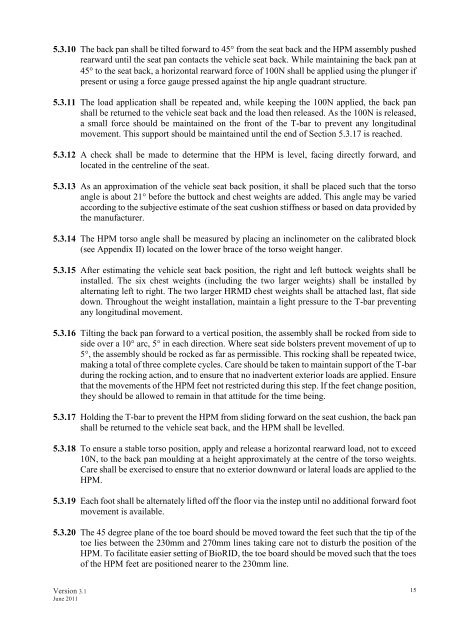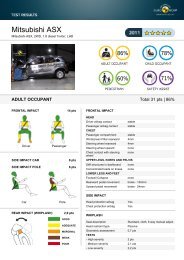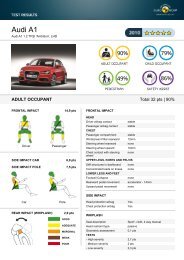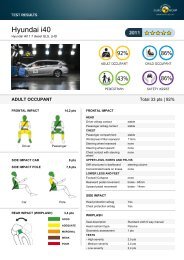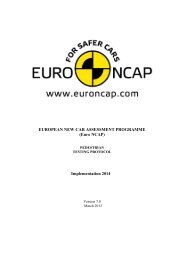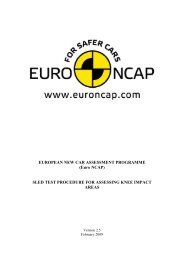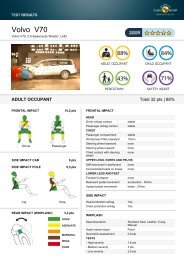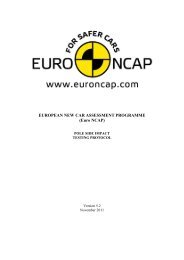Whiplash Testing Protocol - Euro NCAP
Whiplash Testing Protocol - Euro NCAP
Whiplash Testing Protocol - Euro NCAP
You also want an ePaper? Increase the reach of your titles
YUMPU automatically turns print PDFs into web optimized ePapers that Google loves.
5.3.10 The back pan shall be tilted forward to 45 from the seat back and the HPM assembly pushed<br />
rearward until the seat pan contacts the vehicle seat back. While maintaining the back pan at<br />
45 to the seat back, a horizontal rearward force of 100N shall be applied using the plunger if<br />
present or using a force gauge pressed against the hip angle quadrant structure.<br />
5.3.11 The load application shall be repeated and, while keeping the 100N applied, the back pan<br />
shall be returned to the vehicle seat back and the load then released. As the 100N is released,<br />
a small force should be maintained on the front of the T-bar to prevent any longitudinal<br />
movement. This support should be maintained until the end of Section 5.3.17 is reached.<br />
5.3.12 A check shall be made to determine that the HPM is level, facing directly forward, and<br />
located in the centreline of the seat.<br />
5.3.13 As an approximation of the vehicle seat back position, it shall be placed such that the torso<br />
angle is about 21° before the buttock and chest weights are added. This angle may be varied<br />
according to the subjective estimate of the seat cushion stiffness or based on data provided by<br />
the manufacturer.<br />
5.3.14 The HPM torso angle shall be measured by placing an inclinometer on the calibrated block<br />
(see Appendix II) located on the lower brace of the torso weight hanger.<br />
5.3.15 After estimating the vehicle seat back position, the right and left buttock weights shall be<br />
installed. The six chest weights (including the two larger weights) shall be installed by<br />
alternating left to right. The two larger HRMD chest weights shall be attached last, flat side<br />
down. Throughout the weight installation, maintain a light pressure to the T-bar preventing<br />
any longitudinal movement.<br />
5.3.16 Tilting the back pan forward to a vertical position, the assembly shall be rocked from side to<br />
side over a 10° arc, 5° in each direction. Where seat side bolsters prevent movement of up to<br />
5°, the assembly should be rocked as far as permissible. This rocking shall be repeated twice,<br />
making a total of three complete cycles. Care should be taken to maintain support of the T-bar<br />
during the rocking action, and to ensure that no inadvertent exterior loads are applied. Ensure<br />
that the movements of the HPM feet not restricted during this step. If the feet change position,<br />
they should be allowed to remain in that attitude for the time being.<br />
5.3.17 Holding the T-bar to prevent the HPM from sliding forward on the seat cushion, the back pan<br />
shall be returned to the vehicle seat back, and the HPM shall be levelled.<br />
5.3.18 To ensure a stable torso position, apply and release a horizontal rearward load, not to exceed<br />
10N, to the back pan moulding at a height approximately at the centre of the torso weights.<br />
Care shall be exercised to ensure that no exterior downward or lateral loads are applied to the<br />
HPM.<br />
5.3.19 Each foot shall be alternately lifted off the floor via the instep until no additional forward foot<br />
movement is available.<br />
5.3.20 The 45 degree plane of the toe board should be moved toward the feet such that the tip of the<br />
toe lies between the 230mm and 270mm lines taking care not to disturb the position of the<br />
HPM. To facilitate easier setting of BioRID, the toe board should be moved such that the toes<br />
of the HPM feet are positioned nearer to the 230mm line.<br />
Version 3.1<br />
June 2011<br />
15


